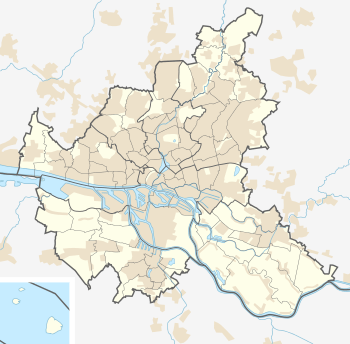Neuengamme concentration camp
| Neuengamme | |
|---|---|
| Concentration camp | |
|
Neuengamme concentration camp perimeter along the Dove Elbe embankment | |
| Coordinates | 53°25′50″N 10°14′1″E / 53.43056°N 10.23361°ECoordinates: 53°25′50″N 10°14′1″E / 53.43056°N 10.23361°E |
| Location | Hamburg, Northern Germany |
| Operated by | Schutzstaffel (SS) |
| Commandant |
|
| Operational | 1938–1945 |
| Killed | unknown (estimated at more than 50,000) |
| Liberated by | British Army |
| Website | Official website of the memorial Neuengamme |
The Neuengamme concentration camp, was a German concentration camp, established in 1938 by the SS near the village of Neuengamme in the Bergedorf district of Hamburg, Germany. It was operated by the Nazis from 1938 to 1945. Over that period an estimated 106,000 prisoners were held at Neuegamme and at its subcamps. More than half of them perished there.[1] After Germany's defeat in 1945, the British Army used the site until 1948 as an internment camp. In 1948, the facility was transferred to the Hamburg prison authority which tore down the camp huts and built a new prison cell block. After being operated as two prisons by the Hamburg authorities from 1950 to 2004, and a period of uncertainty, the site now serves as a memorial. It is situated 15 km southeast of the centre of Hamburg.[2]
Camp operation
In September 1938 the SS-owned company DEST Earth & Stone Works bought the defunct brickyard (German: Klinkerwerk) in Neuengamme. On 13 December 1938 the Neuengamme concentration camp was set up, with the first 100 prisoners coming from the Sachsenhausen concentration camp.[2]
In April 1940 the SS and the city of Hamburg signed a contract for the construction of a larger brick factory, and on 4 June the Neuengamme concentration camp became an independent main camp. .[2]
According to the testimony of Wilhelm Bahr, an ex-medical orderly, during the trial against Bruno Tesch, 200 Russian prisoners of war were gassed by prussic acid in 1942.[3] In April 1942, a crematorium was constructed at the camp. Prior to that all bodies were taken to Hamburg for cremation.[4] In late 1943, most likely November, Neuengamme recorded its first female prisoners according to camp records. In the summer of 1944, Neuengamme received many women prisoners from Auschwitz, as well other camps in the East. All of the women were eventually shipped out to one of its twenty-four female subcamps.
In July 1944, a camp section for prominent prisoners from France was set up. These were political opponents and members of the French resistance who had taken up arms against German forces. They included John William, who had participated in the sabotaging and bombing of a military factory in Montluçon. William discovered his singing voice while cheering his fellow prisoners at Neuengamme and went on to a prominent career as a singer of popular and gospel music.[5] At the end of 1944 the total number of prisoners was around 49,000, with 12,000 in Neuengamme and 37,000 in the subcamps.[2]
On 15 March 1945 the transfer of Scandinavian prisoners from other camps to Neuengamme started. This was part of the White Buses program. On 27 March a Scandinavian camp was established at Neuengamme. On 8 April an air raid on a train transporting prisoners led to the Celle massacre.[2]
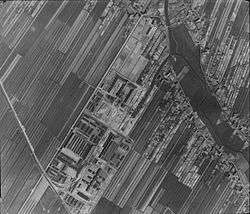
On 26 April 1945 about 10,000 surviving prisoners were loaded into four ships: the passenger liners Deutschland and Cap Arcona and two large steamers, SS Thielbek and Athen. The prisoners were in the ships' holds for several days without food or water.
The order to transfer the prisoners from the camps to the prison ships came from the Hamburg Gauleiter Karl Kaufmann who was himself acting on orders from Berlin. Kaufmann later claimed during a war crimes tribunal that the prisoners were destined for Sweden. However, at the same trial, the head of the Hamburg Gestapo, Georg-Henning Graf von Bassewitz-Behr, said that the prisoners were in fact slated to be killed in compliance with Himmler's orders,[6] and it has been suggested that the plan called for scuttling the ships with the prisoners still aboard.[7]
On 2 May 1945 the SS and the last prisoners left the Neuengamme camp.[2]
On 3 May 1945 the ships were attacked by three squadrons of Royal Air Force Hawker Typhoons. The RAF believed the ships carried SS personnel who were being transferred to Norway; intelligence that the ships carried concentration camp prisoners did not reach the squadrons in time to halt the attack. The Thielbek was sunk and the Cap Arcona and Deutschland set on fire, they both later sank; survivors who jumped into the water were strafed by cannon fire from the RAF aircraft. Thousands of dead were washed ashore just as the British Army occupied the area; the British forced German prisoners-of-war and civilians to dig mass graves to dispose of the bodies.[8]
Extermination through labour
The camp served the needs of the German war machine and also carried out exterminations through labour. The inmates were spread over approximately 80 subcamps across northern Germany. At least 50,000 succumbed to the inhumane conditions in the camp from hard manual work with insufficient nutrition, extremely unhygienic conditions with widespread disease, and violence from the guards.[9][10]
Work at the mother camp was centered on the production of bricks. This included the construction of a canal to transport the bricks to and from the site. Inmates had to excavate the heavy, peaty soil with inadequate tools and regardless of weather conditions or their health state.[9] From 1942, several armaments companies (e.g. Messap, Jastram, and Walther-Werke) established facilities right beside the Neuengamme concentration camp.[11] Walther used their camp facility to manufacture Gewehr 43 semi-automatic rifles.[12]
Subcamps
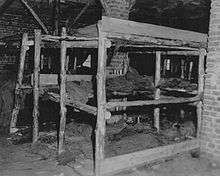
More than 80 subcamps were part of the Neuengamme concentration camp system. First in 1942, inmates of Neuengamme were transported to the camp Arbeitsdorf. The dimensions of the camps differed from about 2,000 inmates to 10 or less. Several of these subcamps have memorials or at least plates, but as of the year 2000 at 28 locations there was nothing to indicate the past presence of a camp.[13] Dr. Garbe, from the Memorial Museum of the Neuengamme concentration camp, wrote, "The importance of the satellite camps is further highlighted by the fact that toward the ends of the war three times more prisoners were in satellite camps than in the main camp."[13]
Neuengamme subcamps on Alderney Island
The Channel Islands were the only part of the British Commonwealth occupied by Nazi Germany. The Germans built four camps, two of which later became Neuengamme subcamps, on Alderney Island—the Alderney camps—and named them after the Frisian Islands: Lager Norderney, Lager Borkum, Lager Sylt and Lager Helgoland. The Nazi Organisation Todt operated each subcamp and used forced labour to build bunkers, gun emplacements, air-raid shelters, and concrete fortifications. The Alderney camps had a total inmate population of about 6,000.
Norderney camp housed slave labourers, mostly eastern European (but also Russian and Spanish). The prisoners in Lager Norderney and Lager Sylt were slave labourers forced to build the many military fortifications and installations throughout Alderney. Sylt camp held Jewish enforced labourers.[14] Lager Borkum was used for German technicians and volunteers from different countries of Europe. Lager Helgoland was filled with Russian Organisation Todt workers.
In March 1943, Lager Norderney, containing Russian and Polish POWs, and Lager Sylt, holding Jews, were placed under the control of the SS Hauptsturmführer Max List. Over 700 of the OT workers lost their lives in the island or travelling to or from it, before the camps were closed and the remaining inmates transferred to Germany in 1944.
Victims
| Country | Men | Women | Total |
|---|---|---|---|
| Soviet Union | 28,450 | 5,900 | 34,350 |
| Poland | 13,000 | 3,900 | 16,900 |
| France | 11,000 | 500 | 11,500 |
| Germany | 8,800 | 400 | 9,200 |
| Netherlands | 6,650 | 300 | 6,950 |
| Belgium | 4,500 | 300 | 4,800 |
| Denmark | 4,800 | - | 4,800 |
| Hungary | 1,400 | 1,200 | 2,600 |
| Norway | 2,200 | - | 2,200 |
| Yugoslavia | 1,400 | 100 | 1,500 |
| Czechoslovakia | 800 | 580 | 1,380 |
| Greece | 1,250 | - | 1,250 |
| Italy | 850 | - | 850 |
| Spain | 750 | - | 750 |
| Austria | 300 | 20 | 320 |
| Luxembourg | 50 | - | 50 |
| Iceland | 1 | - | 1 |
| Other countries | 1,300 | 300 | 1,600 |
| Overall | 87,500 | 13,500 | 101,000 |
| not officially on the lists | - | - | 5,000 |
| Global overall | - | - | 106,000 |
| Dead in deportation | - | - | 55,000 |
Inmates were from 28 nationalities (Soviets (34,350), Polish (16,900), French (11,500), German (9,200), Dutch (6,950), Belgian (4,800), Danish (4,800)) and also from the local Jewish community,[9] but also included communists, homosexuals, prostitutes, Gypsies, Jehovah's Witnesses, prisoners of war and many other persecuted groups. Of 106,000 inmates, almost half died.[15] 20,400 victims, listed by name on the camp memorial Neuengamme, died in the camp and the subcamps. In actuality, an estimated 26,800 victims are known to have died there. During the last days of the camp and “evacuation” about 17,000 people died.[16] At least 42,900 victims can be verified.[17]
Well-known inmates
- Reinder "Rein" Boomsma, Dutch footballer/ Colonel Dutch Army Retd, Commander of Ordedienst Vesting Veluwe.
- Claude Bourdet, French writer and politician
- Emil František Burian, Czech poet, journalist, singer, actor, musician, composer, dramatic adviser, playwright and director
- Jan Campert, Dutch journalist, theater critic, writer and member of the Dutch Resistance
- Robert Domany, Croatian communist, Partisan and national hero of SFR Yugoslavia
- Ernst Goldenbaum, East German politician
- René Gimpel, French art dealer and collector
- Per Johan Græsli, Norwegian physician
- Coen Hissink, Dutch actor
- Michel Hollard, French colonel and member of the French Resistance
- Georges Journois, French Brigadier General and member of the French Resistance
- Anton de Kom, Surinamese resistance fighter
- Henry Wilhelm Kristiansen, Norwegian newspaper editor and politician
- Léonel de Moustier, French politician
- Sergei Nabokov, brother of writer Vladimir Nabokov[18]
- Fritz Pfeffer, German Jew, occupant of the Anne Frank House
- Chava Rosenfarb, Polish Yiddish writer
- David Rousset, French writer and political activist
- Zuzana Růžičková, Czech harpsichordist
- Karl Säre, Estonian politician
- Kurt Schumacher, German politician
- Johann Trollmann, Sinti-German boxer
Camp personnel
There were no SS women stationed at Neuengamme permanently. Female guards were trained at Neuengamme and assigned to its female subcamps. Many of these SS women are known by name, including Kaethe Becker, Erna Dickmann, Johanna Freund, Angelika Grass, Kommandoführerin Loni Gutzeit (who also served at Hamburg-Wandsbek and was nicknamed "The Dragon of Wandsbek" by the prisoners), Gertrud Heise, Frieda Ignatowitz, Gertrud Moeller, who also served at Boizenburg subcamp, Lotte Johanna Radtke, chief wardress Annemie von der Huelst, Inge Marga Marggot Weber. Many of the women were later dispersed to female subcamps throughout northern Germany. Today it is known that female guards staffed the subcamps of Neuengamme at Boizenburg, Braunschweig SS-Reitschule, Hamburg-Sasel, Hamburg-Wandsbek, Helmstedt-Beendorf, Langenhorn, Neugraben, Obernheide, Salzwedel, and Unterluss (Vuterluss). Only a few have been tried for war crimes including Anneliese Kohlmann, who served as one of six women-guards at Neugraben;[19] and Gertrud Heise, Oberaufseherin at Obernheide.[20][21]
The administration at Neuengamme was headed by SS-Sturmführer Alfons Bentele (16 September 1942 – 16 March 1943). Alfred Trzebinski (1902 – 1946) was the SS-physician for the Neuengamme subcamps.
Camp commandants
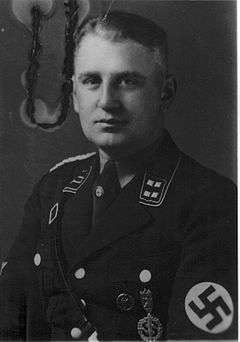
During the period as a subcamp of the Sachsenhausen concentration camp the following SS officers served as Neuengamme Lagerführer (concentration camp commandants).[22]
- SS Sturmbannführer Walter Eisfeld
- SS Hauptsturmführer Martin Gottfried Weiß, April 1940 - June 1940
Erich Frommhagen (SS member from May 1933, ID No. 73754) became adjutant to the commandant of the Neuengamme camp in early 1940. He was killed in action on 17 March 1945.
As an independent concentration camp from June 1940 the following were camp commandants:
- SS Hauptsturmführer Martin Gottfried Weiß, June 1940 - September 1942. His adjutant was Karl-Friedrich Höcker.
- SS Obersturmbannführer Max Pauly, September 1942 - until liberation.
After the war

Following the end of the war, the camp was initially used as a Soviet "DP (Displaced persons) Camp", German prisoners of war were held separately. After June 1945 the camp was used by the British forces as an internment camp for SS members and Nazi officials.
Following guilty verdicts given in the Neuengamme War Trials, on 8 October 1946 British executioner Albert Pierrepoint hanged the following 11 people at Hamelin Prison for war crimes perpetrated at Neuengamme concentration camp during the war: Max Pauly, SS Dr Bruno Kitt, Anton Thumann, Johann Reese, Willy Warnke, SS Dr Alfred Trzebinski, Heinrich Ruge, Wilhem Bahr, Andreas Brems, Wilhelm Dreimann, and Adolf Speck.
Others convicted of crimes committed at Neuengamme received varying terms of imprisonment.
The Civil Internment Camp No. 6 was closed on 13 August 1948. Since 1948 the city of Hamburg used the camp as a prison. Several original buildings of the camp continued to serve as locations in this prison (for example Building Number 9), until February 2006. Since the demolition of the new-build structures in 2007 the whole area is used as a memorial.[23]
Memorial
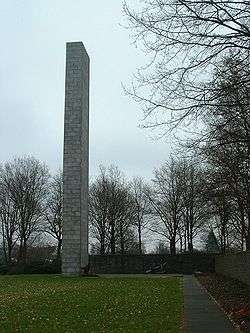
The KZ-Gedenkstätte Neuengamme (Neuengamme memorial site) is located at Jean-Dolidier-Weg 73 in Bergedorf. A first memorial was erected in 1953 on the site of the former camp garden. It was expanded in 1965, and a "document house" was added in 1981. In 1989, the Hamburg Senate decided that the prisons erected in 1950 and 1970 on the camp site should be relocated. The older one was closed in 2003, the newer in 2006. In 2005 a new memorial site and museum were opened. Since 1985, there are also memorials at the subcamps Fuhlsbüttel and Sasel, and in the Bullenhuser Damm school, where a number of children were murdered after being subjected to medical experiments.[24]
Three of the camp's outposts also serve as public memorials. These are located at Bullenhuser Damm, Kritenbarg 8 and Suhrenkamp 98.
The first of these is a memorial to the murder of 20 children from the Auschwitz concentration camp who had been taken to the main camp at Neuengamme and abused for medical experiments. On 20 April 1945, only weeks before the war was over, they were killed at the Bullenhuser Damm school in Hamburg to cover up that crime. The second is an outpost of Neuengamme concentration camp in Hamburg-Sasel where Jewish women from the Łódź Ghetto in Poland were forced to do construction work. The third one is located inside the gatehouse of the Fuhlsbüttel penitentiary. Parts of this complex served as concentration camp for communists, opponents of the regime and many other groups. About 450 inmates were murdered here during the Nazi reign.
Ongoing historical research
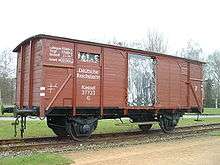
Due to the demolition of the Neuengamme camp and its records by the SS in 1945 and the transportation of inmates to other subcamps or other working locations, the historical work is difficult and ongoing.[25] For example: in 1967 the German Federal Ministry of Justice stated the camp existed from 1 September 1938 until 5 May 1945.[26] In 2008, the organisation of the Neuengamme memorial site (German: KZ-Gedenkstätte Neuengamme)—an establishment of the Hamburg Ministry of Culture, Sports and Media—stated that the empty camp was explored by British forces on 2 May 1945 and the last inmates were liberated in Flensburg on 10 May 1945.[2] The United States Holocaust Memorial Museum stated that the camp was established on 13 December 1938 and liberated on 4 May 1945.[4]
See also
- List of Nazi-German concentration camps
- SS Cap Arcona
- Celler Hasenjagd (Massacre in Celle after an air raid)
Notes
- ↑ Staff (1967-02-23), Verzeichnis der Konzentrationslager und ihrer Außenkommandos gemäß § 42 Abs. 2 BEG (in German), Bundesministerium der Justiz, retrieved 2008-10-12,
11034 Neuengamme, 1.9.1938 bis 5.5.1945 bis 3.6.1940 Sachsenhausen
- 1 2 3 4 5 6 7 KZ-Gedenkstätte Neuengamme: Timeline, Memorial Neuengamme, retrieved 2009-08-18
- ↑ "The Zyklon B Case: Trial of Bruno Tesch and Two Others". United Nations War Crimes Commission. 1947.
- 1 2 "Neuengamme 1938 - 1945 Timeline". USHMM. Archived from the original on September 14, 2009. Retrieved 2008-10-12.
- ↑ Mort de John William, l'inoubliable interprète de La Chanson de Lara... (in French), Yahoo France, 2011-01-09, retrieved 2011-01-10
- ↑ Vaughan, Hal (2004). Doctor to the Resistance: The Heroic True Story of an American Surgeon and His Family in Occupied Paris. Brassey's. pp. 154–156. ISBN 1-57488-773-4.
- ↑ Bond, D. G. (1993). German history and German identity: Uwe Johnson's Jahrestage. Rodopi. pp. 150–151. ISBN 90-5183-459-4.
- ↑ Max Arthur (16 October 2000). "RAF pilots tricked into killing 10,000 camp survivors at end of war". The Independent. Retrieved 10 April 2011.
- 1 2 3 "Neuengamme". USHMM. Retrieved 2009-08-18.
- ↑ "History". KZ Gedenkstätte Neuengamme. Retrieved 2009-08-18.
- ↑ "Satelite Camps". KZ Gedenkstätte Neuengamme. Retrieved 2009-08-18.
- ↑ "Gewehr 43". Imperial War Museum Collections. Imperial War Museum. Retrieved 22 April 2015.
- 1 2 Höhler, Hans-Joachim (2000), Gedenkstätten für die Opfer des KZ Neuengamme und seiner Außenlager, Neuengamme: Arbeitsgemeinschaft Neuengamme and KZ-Gedenkstätte Neuengamme (German) (English) (French) (Russian)
- ↑ Subterranea Britannica (February 2003), SiteName: Lager Sylt Concentration Camp, retrieved 2009-06-06
- ↑ "Neuengamme". USHMM. Retrieved 2008-10-12.
In all, more than 50,000 prisoners, almost half of those imprisoned in the camp during its existence, died in Neuengamme before liberation.
- ↑ Günther Schwarberg: Angriffsziel „Cap Arcona“. Überarb. Neuauflage, Göttingen 1998.“ (German)
- ↑ www.kz-gedenkstaette-neuengamme.de: Death, KZ Gedenkstätte Neuengamme, retrieved 2009-08-19
- ↑ "After his arrest Sergei was taken to Neuengamme, a large labor camp near Hamburg, where he became prisoner No. 28631."
- ↑ "Die Angeklagte Anneliese Kohlmann" (PDF). Aufseherin im KZ Neuengamme (in German). Archived from the original (PDF file, direct download) on May 10, 2006. Retrieved 2013-04-10.
- ↑ Geoffrey P. Megargee (2009). "Gertrud Heise". The United States Holocaust Memorial Museum encyclopedia of camps and ghettos, 1933-1945. Indiana University Press. p. 1097. ISBN 0253354293. Retrieved April 1, 2013.
- ↑ "KZ Aufseherinnen". Majdanek Liste. Axis History ‹ Women in the Reich. 3 Apr 2005. Retrieved April 1, 2013.
See: index or articles ("Personenregister"). Oldenburger OnlineZeitschriftenBibliothek.
Source: Frauen in der SS at the Wayback Machine (archived June 6, 2007) - ↑ "The SS guards". Neuengamme concentration camp. KZ-Gedenkstätte Neuengamme. Retrieved 2013-04-10.
- ↑ KZ-Gedenkstätte Neuengamme: Timeline, Memorial Neuengamme, retrieved 2013-06-13
- ↑ Website concentration camp memorial (German)
- ↑ Staff, Etappen der Lagerräumung (in German), KZ-Gedenkstätte Neuengamme, archived from the original on 2007-09-28, retrieved 2008-09-26
- ↑ Staff (1967-02-23), Verzeichnis der Konzentrationslager und ihrer Außenkommandos gemäß § 42 Abs. 2 BEG (in German), Bundesministerium der Justiz, retrieved 2008-09-26
External links
| Wikimedia Commons has media related to KZ-Gedenkstätte Neuengamme. |
- Official website of the memorial Neuengamme (German)
- jewishgen.org Neuengamme page
- ushmm.org Neuengamme page
- Stichting Vriendenkring Neuengamme (Dutch)
.jpg)

